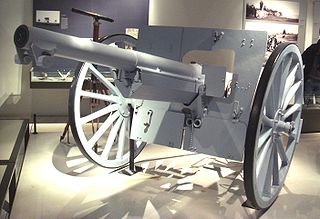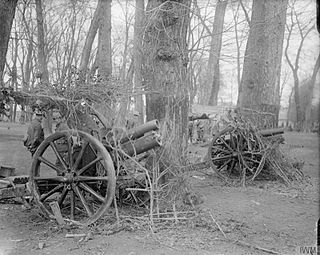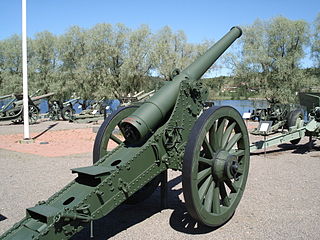
The French 75 mm field gun was a quick-firing field artillery piece adopted in March 1898. Its official French designation was: Matériel de 75mm Mle 1897. It was commonly known as the French 75, simply the 75 and Soixante-Quinze. The French 75 was designed as an anti-personnel weapon system for delivering large volumes of time-fused shrapnel shells on enemy troops advancing in the open. After 1915 and the onset of trench warfare, other types of battlefield missions demanding impact-detonated high-explosive shells prevailed. By 1918 the 75s became the main agents of delivery for toxic gas shells. The 75s also became widely used as truck mounted anti-aircraft artillery. They were also the main armament of the Saint-Chamond tank in 1918.

The 8.8 cm Flak 18/36/37/41 is a German 88 mm anti-aircraft and anti-tank artillery gun from World War II. It was widely used by Germany throughout the war, and was one of the most recognized German weapons of that conflict. Development of the original model led to a wide variety of guns.

The Pak 36 is a 3.7 cm caliber German anti-tank gun used during the Second World War. It was the main anti-tank weapon of Wehrmacht Panzerjäger units until 1942. Developed by Rheinmetall in 1933, it was first issued to the German Army in 1936, with 9,120 being available by the beginning of the war in September 1939 and a further 5,339 produced during the war. As the predominant anti-tank gun design in the world during the late 1930s, demand was high for the Pak 36, with another 6,000 examples produced for export and the design being copied by the Soviet Union as the 45 mm anti-tank gun M1932 (19-K) and by other nations such as Japan.

An artillery tractor, also referred to as a gun tractor, is a specialized heavy-duty form of tractor unit used to tow artillery pieces of varying weights and calibres. It may be wheeled, tracked, or half-tracked.

The 10.5 cm leFH 18 is a German light howitzer used in World War II and the standard artillery piece of the Wehrmacht, adopted for service in 1935 and used by all divisions and artillery battalions. At least 22,133 examples were produced.
3rd Regiment Royal Horse Artillery is a regiment of the Royal Horse Artillery in the British Army. They are currently based at Albemarle Barracks, Northumberland, England.
The Royal Yugoslav Army or Army of the Kingdom of Serbs, Croats and Slovenes was the armed force of the Kingdom of Serbs, Croats and Slovenes from the state's formation in December 1918 until its surrender to the Axis powers on 17 April 1941. Aside from fighting along the Austrian border in 1919–20 related to territorial disputes, and some border skirmishes on its southern borders in the 1920s, the VKJ was not involved in fighting until April 1941 when it was quickly overcome by the German-led invasion of Yugoslavia.

The Ordnance QF 4.5-inch howitzer was the standard British Empire field howitzer of the First World War era. It replaced the BL 5-inch howitzer and equipped some 25% of the field artillery. It entered service in 1910 and remained in service through the interwar period and was last used in the field by British forces in early 1942. It was generally horse drawn until mechanisation in the 1930s.

This article is about the Italian Royal Army which participated in World War II.

The Krupp 7.5 cm Model 1903 was a field gun used by a number of European armies in both World War I and World War II. The Model 1903 was a "stock gun" from Krupp that could be supplied to customers on short notice with minor alterations to suit the customers needs.

The 54th Infantry Division Napoli was a regular infantry division of the Italian Army during World War II. It was created 15 April 1939 in Caltanissetta and was dissolved 14 August 1943 in Melia southeast of Scilla, Calabria after being nearly wiped out in the Allied invasion of Sicily. The division drafted men in southern Sicily. The members of the division hailed from Caltanissetta, Agrigento, Syracuse and surrounding territories.

The 75 mm Gun M1916 was a US Army field artillery piece used during and after World War I. It was used as an anti-aircraft gun as well as a field piece. It originated as the 3-inch Gun M1913, which was soon modified to the 3-inch Gun M1916, which was later altered to the subject weapon.
The Royal Albanian Guard was from 1928 till 1939 and was part of the Royal Albanian Army.
XIV Brigade, Royal Horse Artillery was a brigade of the Royal Horse Artillery which existed in the early part of the 20th century. It had been dissolved before World War I but was reformed for the war. It served with 7th Division on the Western Front before becoming XIV Army Brigade, RHA in February 1917. It was disbanded at the end of the war.
The coastal batteries of Romania had a significant role to play in the country's naval warfare.
The Battle of Durrës was one of the main confrontations during the April 1939 Italian invasion of Albania. It took place on 7 April, the first day of the invasion, between the Italian invaders and the Albanian defenders and resulted in an Italian victory.

The Canon de 120 mm L modèle 1878 - was a French piece of siege and field artillery which was widely used during the First World War and despite its obsolescence, it was still in use by some nations during the Second World War.

The 7.7 cm Leichte Kraftwagengeschütze M1914 was an early German self-propelled anti-aircraft gun developed before and used during the First World War. Static and trailer mounted versions of the gun were designated 7.7 cm FlaK L/27.

The 8 cm Kanone C/80 was a field gun developed during the late 1800s by Krupp for the export market. It saw action in numerous regional conflicts as well as World War I.














